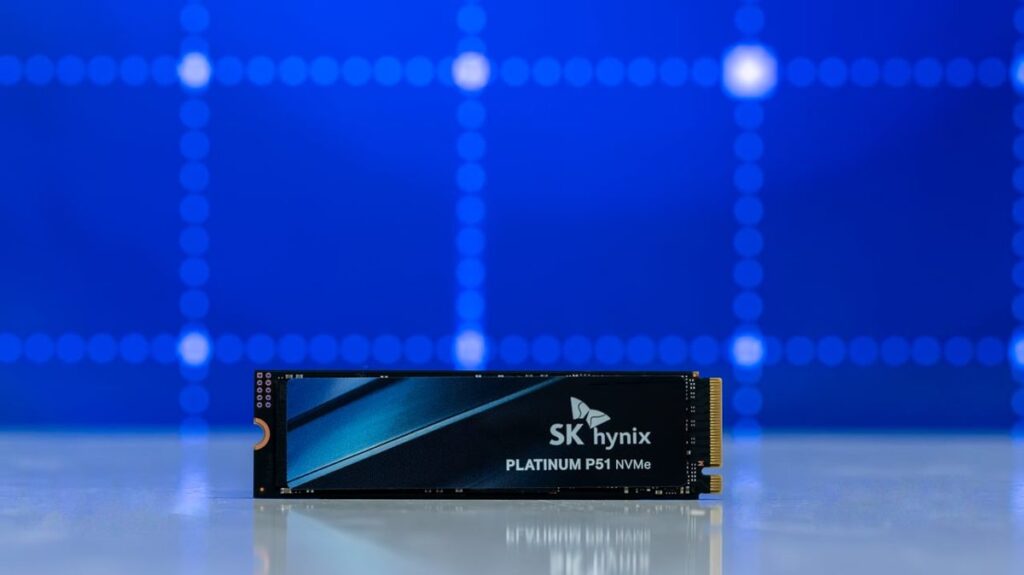
The SK Hynix Platinum P51, starting at $199.99 for 1TB and $319.99 for 2TB, marks the South Korean semiconductor giant’s debut into the PCI Express (PCIe) 5.0 solid-state drive (SSD) market. Leveraging its in-house expertise, SK Hynix has developed a drive that boasts impressive throughput numbers, although it falls short of the five-star rated WD Black SN8100, the current favorite in the PCIe 5.0 category. While the P51 offers solid performance, its appeal would be significantly enhanced by a lower price point and larger capacity options.
Design and Components: Homegrown Innovation
The Platinum P51 is a four-lane SSD operating on the NVMe 2.0 protocol over a PCIe 5.0 bus, housed in the standard M.2 Type-2280 format. This single-sided drive incorporates SK Hynix’s own components, including 238-layer 3D TLC NAND flash and the Hynix Alistar controller. Notably, the controller features a dynamic random access memory (DRAM) cache, distinguishing it from recent DRAM-less models like the Crucial P510 and Addlink G55H, which rely on the host memory buffer (HMB) for caching.
Designed with power efficiency in mind, the P51’s consumption peaks at 10 watts. However, this figure is not particularly groundbreaking, as competitors like the WD Black SN8100 operate at a maximum of 7 watts. As PCIe 5.0 SSDs strive to become mainstream, manufacturers are increasingly emphasizing power savings.
Thermal Considerations
While SK Hynix does not currently offer the P51 with a bundled heatsink, it is advisable to use one for PCIe 4.0 or 5.0 SSDs. Ensuring your motherboard has an adequate thermal solution is crucial, especially for desktop systems utilizing the PCIe 5.0 slot.
System Requirements: Compatibility and Configuration
To fully exploit the speed of PCIe 5.0 SSDs like the P51, users need compatible hardware. Recent high-end desktops and select laptops support PCIe 5.0, but others may require a custom build or system upgrade. Essential components include an Intel 12th Gen or later Core CPU with a Z690 or Z790 chipset motherboard, or an AMD Ryzen 7000 or 9000 processor with an AM5 motherboard based on an X670, X670E, or B650E chipset.
However, having the right chipset doesn’t guarantee a PCIe 5.0-capable M.2 slot, as this depends on the motherboard manufacturer. It’s crucial to verify your system’s specifications to ensure compatibility before purchasing a PCIe 5.0 SSD.
Price and Capacity: Limited Options
With PCIe 5.0 SSD capacities reaching up to 4TB, and some manufacturers promising 8TB versions, the P51’s 2TB maximum feels restrictive. Priced between $250 and $260, it competes with premium SSDs like the WD Black SN8100. The P51’s durability rating is comparable to many Gen 5 SSDs, although it falls short of models like the ADATA Legend 970 and Seagate FireCuda 540, which boast higher TBW ratings.
SK Hynix provides a five-year warranty or until the rated TBW is reached, ensuring longevity unless subjected to unusually high data writes.
Performance: Speed Meets Real-World Testing
Testing the Platinum P51 involved a high-performance setup featuring an ASRock X670E Taichi motherboard, AMD Ryzen 9 7900 CPU, and a PCIe 5.0 x4 M.2 slot. The drive was evaluated using benchmarks such as Crystal DiskMark 6.0, UL’s PCMark 10 Storage, and UL’s 3DMark Storage.
The P51 delivered on its rated speeds, achieving the third-fastest sequential read and second-fastest sequential write speeds in Crystal DiskMark tests. However, its 4K performance was average, important for SSDs used as boot drives.
In PCMark 10’s Overall Storage test, the P51 ranked fourth, excelling in specific gaming-related tasks but lagging in others. Its 3DMark 10 score was middling, aligning with many Gen 5 SSDs but falling short of top performers like the Crucial T705 and WD SN8100.
As SK Hynix ventures further into the PCIe 5.0 market, the Platinum P51 represents a solid entry, though improvements in pricing and capacity could enhance its competitiveness. The drive’s performance and efficiency position it well for users seeking a high-speed storage solution, provided their systems meet the necessary requirements.






